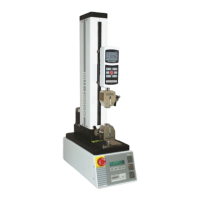Model ESM301 / ESM301L Test Stand User’s Guide
22
1. Cancel the cycle sequence:
Press RESET to stop and reset the cycle sequence. The cycle counter will revert to the
number of cycles originally programmed.
2. Resume the cycle sequence:
Press UP or DOWN to resume.
Once the sequence has been completed, the screen will revert to the number of cycles programmed
originally. To begin another cycle test, press UP or DOWN.
Travel indication and limit switch operation is the same as in Basic Mode.
5.5 Preload Mode
In this mode, the crosshead moves at the set speed (10 in/min [250 mm/min] maximum) until the
programmed preload value has been reached. If moving in the up direction, a tension preload is required.
If moving in the down direction, a compression preload is required. When the preload is reached, the
sequence of events programmed in the Preload feature occurs. If the ZERO,GO setting is selected, and
if the set speed is greater than 10 in/min, the crosshead speed will revert to this setting after the travel
indicator is zeroed.
Note 1:
Before the start of a preload sequence, the crosshead must be positioned at either the upper or lower
physical limit switch.
Note 2:
Preload and Loadholding cannot be enabled simultaneously.
5.6 Loadholding Mode
In this mode, the crosshead moves until the set point value programmed in the force gauge is reached.
The crosshead then dynamically adjusts its position to maintain a programmed force. The force gauge’s
capacity should be as close as possible to the intended load, for best performance.
In the force gauge, both set points must be set. The upper set point refers to a force limit in the up
(tension) direction. The lower set point refers to a force limit in the down (compression) direction. The
opposite set point must be set to any value in the opposite measuring direction. For example, for a test
requiring load holding at 10 lbF of compression force, set the upper set point to 30 lbF tension (as an
example), and the lower set point to 10 lbF compression.
If the CYCLING option has been enabled, loadholding will be active for the period of time as defined in
the Dwell Time settings. If CYCLING has not been enabled, load holding will continue indefinitely.
Before the start of a load holding sequence, the crosshead must be positioned at either the upper limit
switch to begin compression loadholding or at the lower limit switch to begin tension loadholding.
An appropriate speed should be chosen for a given sample. Fine tuning may be necessary to ensure
optimal crosshead dynamic behavior. Stiff samples require a lower test speed; softer samples can be
tested at higher speeds. If the speed of approach is too high for a given sample stiffness, the crosshead
may overshoot the set point value, requiring an adjustment sequence where the crosshead reverses, then
moves again in the original direction multiple times before settling at the set point value. A high enough
speed may cause this correction cycle to repeat indefinitely.
For softer samples the amplitude of oscillation will be smaller, but could still be present for the duration of
the loadholding period. This is typical for samples which may relax, such as rubber, foam, etc. Lowering
the test speed will reduce the oscillation.

